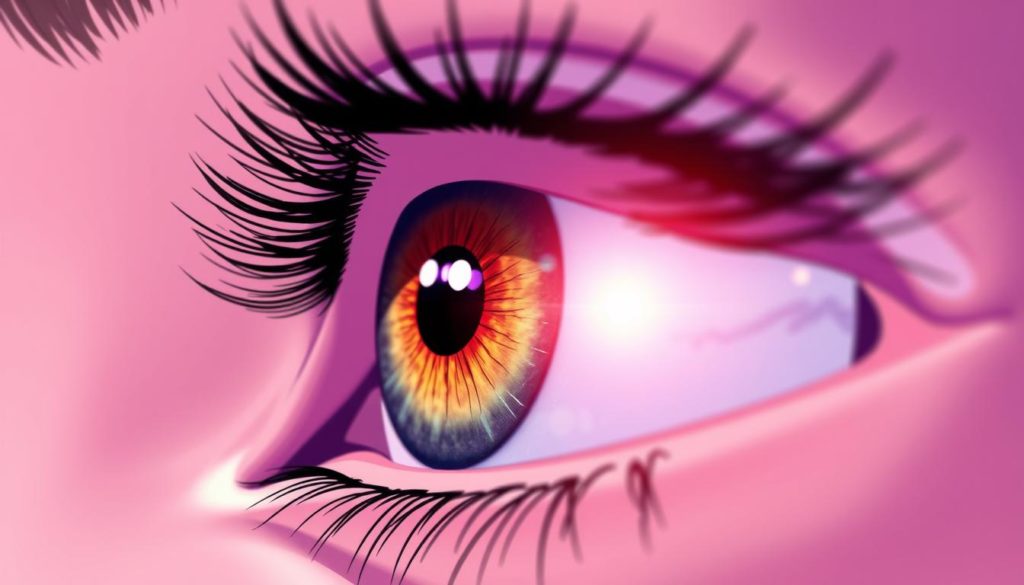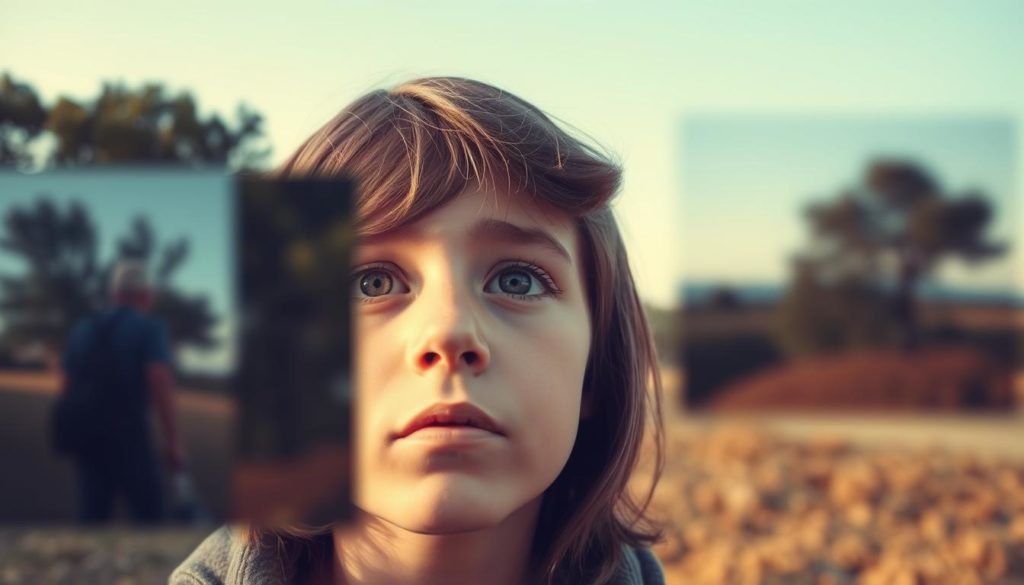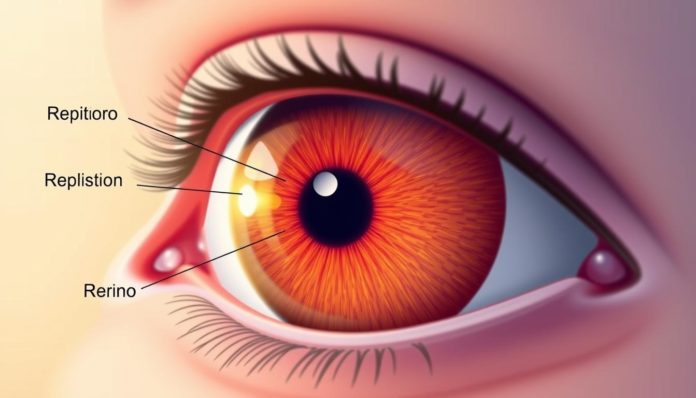Did you know that by 2050, nearly half of the world’s population is expected to have myopia? This is a shocking fact, especially in countries like the United States. In this overview, you’ll learn more about myopia and why keeping your vision healthy is key.
Myopia, or nearsightedness, makes it hard to see things far away. But you can see things up close just fine. This condition affects millions and puts a big strain on healthcare worldwide. Things like genetics and too much screen time are making myopia worse. It’s important to understand this and find ways to manage it.
What is Myopia?
Myopia, also known as nearsightedness, is a common vision problem. It makes distant objects seem blurry, but close things are clear. The myopia definition comes from a refractive error in the eye. This error happens when light rays focus in front of the retina, not directly on it.
This usually occurs because the eyeball is too long. Or, there might be issues with the eye lens and cornea’s shape.

In a normal eye, the cornea and eye lens work together. They focus light onto the retina at the back of the eye, making images clear. But, with myopia, this process is disrupted. This leads to focus problems with distant vision.
The exact causes of these eye lens issues are still not fully understood. Both genetics and environmental factors are thought to play a role.
| Feature | Normal Eye | Myopic Eye |
|---|---|---|
| Eyeball Shape | Normal length | Elongated |
| Light Focus | On the retina | In front of the retina |
| Vision Clarity | Clear distance vision | Blurred distance vision |
Common Nearsightedness Symptoms
Nearsightedness, or myopia, shows in many ways that can change your daily life. Knowing these signs is key to catching the problem early and getting the right treatment.
Blurred Distance Vision
One big symptom of nearsightedness is blurred vision when you look at things far away. It can make watching movies or seeing faces from afar hard.

Frequent Headaches
Myopia often causes headaches. Trying to focus on far-off things strains your eye muscles. This leads to eye pain and headaches that won’t go away.
Eye Strain
Eye strain is another common sign of myopia. Trying hard to see things far away can make your eyes tired and sore. This feeling gets worse after you’ve been trying to focus for a long time.
Difficulty Seeing at Night
Many people with myopia have trouble seeing in the dark. Driving or moving around in dim light can be really hard. It can even be dangerous.
Causes of Myopia
Myopia causes involve genetics and the environment. Knowing these factors helps us tackle nearsightedness better.
Genetic factors are key in myopia. If your parents have it, you’re more likely to too. Certain genes affect eye growth, making some more prone to myopia.
But, environmental influences matter too. Today, too much screen time and near work are common causes. These activities strain your eyes, potentially making your eyeball longer, which is a sign of myopia.
Outdoor activities are good for your eyes. Kids who spend more time outside are less likely to get myopia. Natural light and looking at distant objects help keep eyes healthy, fighting against near work’s effects.
“Recent studies highlight that both genetics and lifestyle choices contribute to the increasing prevalence of myopia worldwide.”
| Factors | Description |
|---|---|
| Genetic Factors | Family history and specific genes increase risk. |
| Environmental Influences | Prolonged screen time and near work contribute to eye strain. |
| Outdoor Activities | Exposure to natural light and distance focusing reduce risk. |
Understanding myopia causes helps us fight this common vision problem. We can take steps to prevent it in the future.
How is Myopia Diagnosed?
Learning about myopia diagnosis can help you protect your eye health. It involves several tests during a detailed eye exam. These tests help check your vision and eye health accurately.
Eye Examination
A thorough eye exam is the first step to find out if you have myopia. An eye doctor will look at your eye’s health and how well you see. They check for any problems and see how well your vision is.
Refraction Tests
Refraction tests are key in diagnosing myopia. They see how light bends when it goes through your eye. By trying different lenses, the doctor finds the right glasses or contacts for you.
Visual Acuity Tests
Visual acuity tests check how clear your vision is. You’ll look at an eye chart with letters of different sizes. How well you can read these letters shows if you need glasses or contacts.
To sum up, knowing about the tests in an eye exam is crucial for a correct myopia diagnosis. Eye exams, refraction tests, and visual acuity tests all help ensure you get the best eye care.
Myopia Risk Factors
Myopia is becoming more common in many groups. This is due to both genetic and lifestyle factors. Knowing these risk factors helps us spot who is most at risk, especially kids and teens.
Genetics are a big part of myopia. If your parents are nearsighted, you might be too. But lifestyle also matters. Using devices like phones and tablets a lot can make myopia more common, especially in young people.
Environmental factors also play a role. Being indoors a lot, with little natural light, can increase myopia risk. It’s important to get kids outside more.
It’s key to find out who is at high risk early on. This includes kids with myopia in their family, those who read or use screens a lot, and those who don’t get outside much. Changing these lifestyle habits can help lower myopia risk.
| Risk Factor | Details |
|---|---|
| Genetics | Family history of myopia increases the likelihood of developing the condition. |
| Screen Time | Excessive use of electronic devices is linked to higher rates of myopia. |
| Indoor Activities | Spending less time outdoors and more time indoors can elevate myopia risks. |
In short, knowing about myopia risk factors and changing lifestyle habits is key to managing and preventing it. By being aware and taking action, we can protect those at high risk from myopia’s negative effects.
Impact of Myopia on Daily Life
Myopia affects many parts of our daily lives, causing challenges in different settings. Knowing these challenges helps us cope better and find solutions.
Challenges in School or Work
Students and workers with myopia face big hurdles, especially where clear distance vision is key. Reading from whiteboards or seeing colleagues from afar is tough. These issues can cause stress and lower productivity, affecting school or work performance.
Reduced Driving Safety
Myopia can make driving at night or in low light very dangerous. It can make it hard to see road signs or obstacles from far away. This increases the risk of accidents.
Adapting to Corrective Lenses
Adapting to glasses or contact lenses is crucial for managing myopia. These tools improve vision but need time to get used to. They also require regular care, changing how we live our lives.
Effective Treatment Options for Myopia
There are many ways to treat myopia, depending on your needs and lifestyle. The main options include corrective lenses and different types of refractive surgery.
Corrective Lenses: Eyeglasses and contact lenses are the most common treatments. Eyeglasses are simple and non-invasive. Contact lenses offer better vision and are great for those who are always on the move.
Refractive Surgery Options: LASIK and Ortho-K are long-term solutions. LASIK changes the shape of your cornea for better vision. Ortho-K uses special contact lenses to reshape your cornea while you sleep.
The latest advancements in myopia management also include atropine eye drops and multifocal contact lenses, aimed at slowing the progression of myopia, especially in children.
Here’s a table to help you understand the pros and cons of these treatments:
| Treatment | Pros | Cons |
|---|---|---|
| Eyeglasses |
|
|
| Contact Lenses |
|
|
| LASIK Surgery |
|
|
| Ortho-K |
|
|
Myopia Prevention Strategies
Preventing myopia, or nearsightedness, requires simple lifestyle changes. Adding eye health activities to your daily routine can slow or stop myopia. Here are some key strategies for better vision.
Outdoor Activities
Spending time outdoors is a top way to prevent myopia. Studies show natural light and varied distances reduce nearsightedness risk. Encourage everyone to spend at least two hours a day outside. Activities like walking or playing sports are great.
Limit Screen Time
Reducing screen time is key for eye health in today’s world. Too much computer, tablet, or phone use can strain eyes and worsen myopia. Use the 20-20-20 rule: every 20 minutes, look 20 feet away for 20 seconds. This helps reduce eye strain and improves vision.
Regular Eye Checkups
Regular eye exams are crucial for myopia prevention. Seeing an optometrist regularly helps catch early signs of myopia. This ensures your vision correction is always right. Don’t wait for symptoms; keep your eyes healthy with regular exams.
FAQ
What are the common symptoms of myopia?
Myopia symptoms include blurred distance vision and headaches. You might also feel eye strain or struggle with night vision. If you notice these signs, see an eye doctor.
What causes myopia?
Myopia comes from genes and lifestyle. Too much screen time and less outdoor play can raise your risk. These habits can lead to myopia.
How is myopia diagnosed?
Eye doctors use tests to find myopia. They check how well you see at different distances. This helps them understand your vision needs.
What treatment options are available for myopia?
Treatments include glasses, contact lenses, and LASIK surgery. Ortho-K and atropine drops are also options. These help slow myopia in kids.
Are there ways to prevent myopia?
Yes, to prevent myopia, spend more time outside and less on screens. Regular eye exams are also key. They help catch vision problems early.
What are the risk factors for developing myopia?
Risk factors include genetics and too much screen time. Excessive close-up work and less outdoor play also increase risk. Kids are especially vulnerable.


